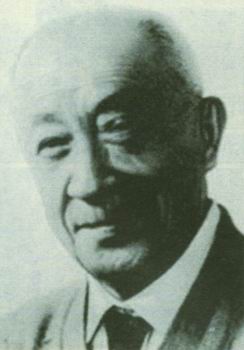Wan Laiming facts for kids
Quick facts for kids
Wan Laiming
|
|
|---|---|
 |
|
| Born |
Wan Laiming
January 18, 1900 |
| Died | October 7, 1997 (aged 97) |
| Nationality | Chinese |
| Occupation | animator artist inventor film director |
Wan Laiming (born January 18, 1900 – died October 7, 1997) was a very important person in the world of Chinese animation. He was born in Nanjing, China. Wan Laiming was one of the famous Wan brothers who helped start the animation industry in China. Many people think of him as China's very first animator! He even became the director of the Shanghai Animation Film Studio, helping Chinese cartoons become famous around the world.
Contents
Early Life and Animation Beginnings
Wan Laiming and his brother, Wan Guchan, were twins. They were among the first people in China to experiment with early film technology. They got ideas from cartoons made in other countries that came to Shanghai.
In 1919, the brothers worked in the art departments at a company called Shanghai Commercial Press. There, they saw early animation tools like the zoetrope. A zoetrope is a spinning device that makes pictures look like they are moving, like a horse galloping. They studied how these early cinema tricks worked.
One summer evening in the early 1920s, the brothers were in a small attic. They used a thick book and drew pictures of a cat and a mouse. By bending the corners of the book, they made it look like the cat was chasing and catching the mouse! The brothers spent many days testing and trying out new ideas.
Pioneering Chinese Animation
In 1922, the Wan brothers created China's first short cartoon. It was called Shuzhendong Chinese Typewriter and was a commercial for the Commercial Press company. One of their first challenges was making the background of their animations look right.
In 1924, they were asked to join the Great Wall Film Company to make an animated film in a studio. Wan Laiming and Wan Guchan became known as China's animation pioneers when they successfully made the first animated short film, Uproar in the Studio. This film was about 10 to 12 minutes long and was in black and white.
By 1935, the Wan Brothers made another big step: they launched China's first animated film with sound, called The Camel's Dance.
Animation During Wartime
In 1938, the three remaining Wan Brothers moved from Shanghai to Wuhan. Later, Wan Dihuan went back to Chongqing to create animations that supported China against the Japanese invasion. Wan Laiming also joined a group that used films to help their country during the Second Sino-Japanese War. They combined war songs with animations to create powerful messages.
In 1939, the brothers were inspired by the American film Snow White. They wanted to create a film just as good to bring honor to China. By 1940, the brothers worked for the Xinhua Film Company, which was one of the few film companies still open during the Japanese occupation.
The manager of the company, Zhang Shankun, was worried about how expensive animation was. But Wan Laiming promised they wouldn't lose money. Even though Shanghai was partly occupied by Japanese forces, they finished Princess Iron Fan. This was the first Chinese animated film of a long length, and it was a proud achievement for the people who remained in the city.
Wan Guchan wanted to start their next big project, Havoc in Heaven. But as the Japanese occupation grew, their animation department had to close. Investors pulled their money, and the project couldn't start.
Later Achievements and Legacy
Years later, in 1950, the Shanghai Animation Film Studio was finally created.
In 1954, Wan Laiming went to Hong Kong and then returned to Shanghai. He became the director of the Shanghai Animation Film Studio. Two years later, in 1956, Wan Laiming created China's first animated film in color, called Why is the Crow Black-Coated.
The dream of Havoc in Heaven finally came true in 1961 when Wan Laiming and Wan Guchan got to work on the first part of the film. By 1964, all four Wan brothers worked together on the final part of the movie. Havoc in Heaven won international awards, showing the world that China could make high-quality animated films.
Unfortunately, in 1966, a period called the Cultural Revolution began in China. This time was very difficult for many artists, and the animation industry suffered greatly. This marked the end of China's "golden era" of animated films for a while.
Death and Remembrance
Wan Laiming passed away in Shanghai on October 7, 1997. He was buried at Fushouyuan Zhonglingyuan, and a statue was built there to honor his amazing contributions to the animation world.
Images for kids


